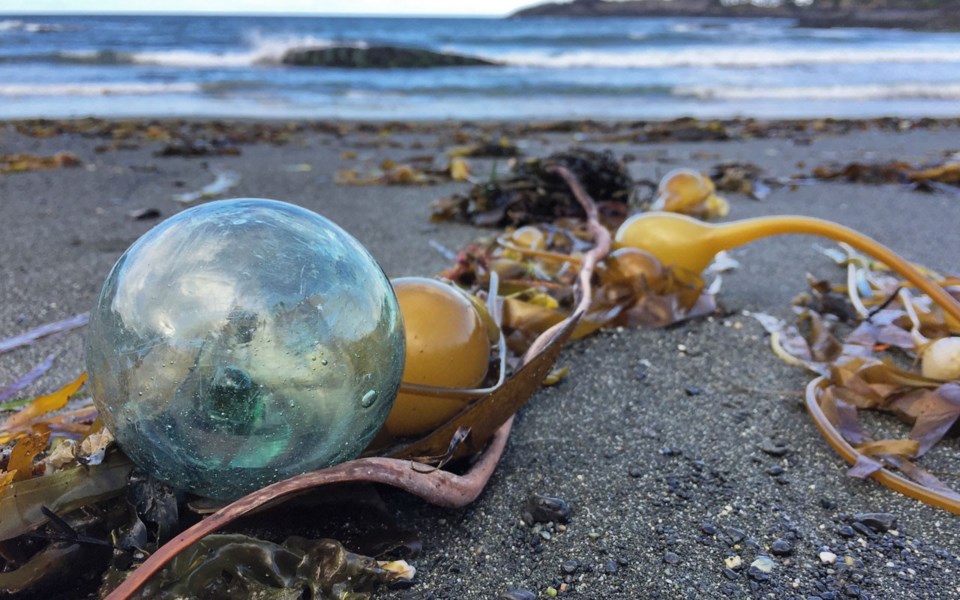Breakfast is over, but it's still early as the Island Solitude manoeuvres up the inlet on a falling tide. Dropping anchor, we pile into Zodiacs and head for a cove now constellated with barnacle-encrusted boulders. Tying the rafts to trees, we bushwhack over a forested isthmus, crawling under a tangle of winter blowdown onto a flat bench of grassy tussocks rimmed by a palisade of massive fir. Beyond this final picket lies a small, half-moon beach exposed to the full force of the Pacific, its tideline piled high with massive logs. Visions of rival characters Nick and Relic of CBC's The Beachcombers come to mind, leaving me shaking my head at how such a thin premise was translated into such a popular, long-running series. But maybe it wasn't so thin after all; these logs are surely worth something in a one-man's-trash-is-another-man's-treasure kind of way, even if the cost of recovering them no longer makes sense.
Walking the beach, tracks of otter and deer crisscross the black sand while ravens and eagles peer down from Hemlock towers; the only human footprints on this strand are ours, the first in over a year. Treasure indeed.
Gwaii Haanas National Park provides a rare opportunity to explore the kind of pristine coastal wilderness now before us. These isolated islands off B.C.'s north coast are difficult to reach, requiring a floatplane or boat, and we're happy to sail with the most venerable company to provide such service—Bluewater Adventures. But after lazy days spent tracking spectacular archipelagic scenery, photographing humpback whales, and visiting key cultural sites of the Haida people who've occupied these islands for millennia, we haven't hiked into Bowles Beach to notch another touristic superlative. Instead we're here to give back—by taking away, so to speak. Brandishing burlap sacks, we fan out to collect a winter's worth of washed-up trash—which is to say, plastic.
Immediately, it's clear that the most common items are plastic drink bottles, either whole or pounded into bits by the surf. The latter is unsurprising given how many have travelled the full breadth of the Pacific to arrive here, and we find bottles with labels in Chinese, Japanese, Korean, Thai, Malaysian and even Russian. The remaining myriad jetsam includes food containers, mounds of fishing nets and tangled rope, Styrofoam of every description, dishwashing pads, plastic cigar tips, even toothbrushes.
Fittingly, the trash detail takes on the air of a treasure hunt, and our group becomes more diligent, peering between logs for stray bits, yanking out things buried in sand, generally relishing the chance to make a difference if only to one tiny beach in the vast North Pacific. After an hour, during a final tideline sweep, I spot something distinctly different from my armload of plastic shards—a blue-green, mouthblown, glass fishing-net float from Japan, the only place where this art is still practiced. Though I don't know it at the time, the following winter, I'll visit the Japanese port of Otaru on the island of Hokkaido, where the floats are actually made, closing a circle I never thought I'd be part of. At that moment, however, I simply head back to Island Solitude bearing not only my burlap-bagged cleanup effort, but a treasure seemingly plucked from the trash heap of humanity.
Bluewater adheres to the core ecotourism principals of employing low-impact practices, supporting local communities, promoting conservation, and providing guests with high-level knowledge about wildlife, Indigenous cultures, and the environment—hence the opportunity for both learning and action when it comes to water-borne plastics, an experience that would soon inspire our group to double down.
A few days later, we anchor in expansive Luxana Bay with the intention of going ashore for a leisurely beach walk. Before long, however, we're all picking up plastic again, and over two hours later, have stacked a literal ton of it onto the expansive tidal flats: more ropes and nets, floats and buoys, packing containers and trays, Taiwanese water bottles and Russian toothpaste. The bay is so large we've only made the tiniest dent, but are nevertheless satisfied with the Zodiac-load of garbage we drop at a warden cabin the next day, where other park visitors have also dropped their own clean-up efforts.
The message is clear: when it comes to reducing plastic in the environment, every little bit helps, and we can all do more. But a rethink of your own relationship to plastics doesn't require going to a remote beach—though the beach is happy to have you—it simply means committing to reducing plastic consumption in daily life, and cleaning up where you can. Who knows, it might even lead you to some kind of treasure.
Leslie Anthony is a biologist, writer and author of several popular books on environmental science.




